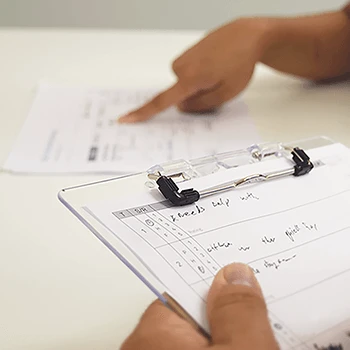What makes an expert usability review different from user testing, and when should each approach be used?
Expert usability reviews involve trained UX professionals evaluating your website against established usability principles and heuristics, while user testing observes real users completing tasks. An expert review is ideal when timeline or budget constraints make user testing impractical, when you need quick identification of obvious usability violations, or as preliminary analysis before user testing. Our Experience Thinking approach combines expert evaluation of brand, content, product, and service experiences to provide holistic usability assessment. A review has the potential to identify 75-80% of major usability issues quickly, making it valuable for rapid iteration cycles, competitive analysis, or initial design validation. However, expert reviews cannot replace user testing for understanding emotional responses, task completion patterns, or unexpected user behaviors.
Tip: Use expert usability review for initial design validation and quick wins, then follow with targeted user testing to validate critical user journeys and emotional responses.
How do you ensure expert usability reviews are objective and not influenced by internal biases?
We maintain objectivity through structured evaluation frameworks, multiple reviewer perspectives, and evidence-based assessment against established usability principles rather than personal preferences. Our process includes evaluation phases where reviewers assess experieneces within the business context. We use standardized evaluation criteria including Akendi's heuristics, accessibility guidelines, and industry-specific usability standards. Multiple experts review the same interfaces independently, then collaborate to identify consensus issues and discuss divergent findings. Our documentation process requires specific evidence citations and user impact explanations for each identified issue. We also validate findings against user behavior data when available to ensure recommendations align with actual user experience patterns.
Tip: Request that reviewers document their evaluation criteria and provide specific examples of usability violations rather than general recommendations to ensure objectivity.
What usability principles and heuristics guide your expert evaluation process?
Our evaluation process integrates established usability heuristics including Nielsen's ten principles, accessibility guidelines (WCAG), and Akendi's design principles focused on supporting user capabilities, showing users what they need, responding to user actions, building on user knowledge, empowering users, helping users out of trouble, and saving users time and effort. We evaluate visibility of system status, match between system and real world, user control and freedom, consistency and standards, error prevention, recognition rather than recall, flexibility and efficiency, aesthetic and minimalist design, error recovery, and help documentation. Our Experience Thinking framework adds evaluation of how usability supports brand experience, content experience, product experience, and service experience across the complete user journey. We also assess mobile usability, performance impact on user experience, and emerging interaction patterns.
Tip: Ask for evaluation results organized by usability principle to understand not just what issues exist, but why they impact user experience and how they connect to broader design patterns.
How does foresight design influence your approach to identifying future usability challenges?
Foresight design in usability evaluation involves anticipating how user behavior evolution, technology advancement, and changing expectations will affect current design decisions. We assess interfaces against emerging interaction patterns, mobile-first usage trends, voice interface integration, and accessibility requirement changes. Our forward-thinking evaluation considers how AI-powered personalization will affect navigation patterns, how voice search optimization impacts content findability, and how cross-device usage scenarios influence current design choices. We evaluate scalability of current design patterns, examine competitive landscape evolution, and identify architectural decisions that might limit future usability enhancements. This approach helps prevent costly redesigns by identifying current decisions that could become usability barriers as user expectations and technology capabilities evolve over the next 2-3 years.
Tip: Include discussion of future user behavior trends and technology adoption in your evaluation scope to identify proactive usability improvements rather than just current issues.
What's the typical scope and depth of a usability review engagement?
Usability review scope varies from targeted assessment of specific user flows to complete website evaluation across all major functionality and content areas. Typical engagements include homepage and key landing page analysis, primary task flow evaluation, navigation system assessment, mobile responsiveness review, accessibility compliance check, and content usability evaluation. Deep reviews examine information architecture effectiveness, search functionality, form usability, error handling, performance impact on user experience, and cross-browser compatibility issues. Our Experience Thinking methodology ensures evaluation covers how usability supports brand perception, content consumption, product interaction, and service delivery across the complete user lifecycle. Scope planning considers business priorities, user segment importance, and technical implementation constraints to focus evaluation effort on highest-impact improvements.
Tip: Prioritize evaluation scope based on your highest-traffic pages and most critical business conversion paths rather than trying to evaluate everything equally.
How do you adapt usability evaluation for different industries and user contexts?
Industry-specific usability evaluation requires understanding domain conventions, regulatory requirements, user expertise levels, and task complexity variations that affect usability standards. We adapt evaluation criteria for healthcare applications requiring HIPAA compliance and complex workflow support, financial services needing security perception and trust indicators, e-commerce requiring conversion optimization and product discovery, and B2B applications serving expert users with efficiency priorities. Our evaluation considers industry-specific user mental models, terminology expectations, and workflow patterns. We assess compliance with sector-specific accessibility requirements, evaluate appropriate use of industry conventions versus innovation opportunities, and understand how user stress levels or expertise affect interaction patterns. The approach balances following established patterns users expect with opportunities for competitive differentiation through superior usability.
Tip: Provide context about your industry's unique user behaviors and regulatory requirements during evaluation planning to ensure industry-appropriate usability assessment.
What role does accessibility evaluation play in your usability review process?
Accessibility evaluation is integral to our usability review process since accessible design benefits all users, not just those with disabilities. We assess compliance with WCAG guidelines, evaluate keyboard navigation effectiveness, check color contrast and visual design accessibility, test screen reader compatibility, and examine cognitive load reduction for users with different abilities. Our evaluation includes automated accessibility scanning combined with manual testing of actual user pathways using assistive technologies. We assess how accessibility features affect overall user experience, identify opportunities where accessibility improvements enhance general usability, and evaluate the impact of accessibility barriers on business goals. Accessibility assessment also considers mobile accessibility, voice interface preparation, and inclusive design principles that expand your potential user base.
Tip: Consider accessibility evaluation as usability enhancement rather than compliance obligation, since accessible design typically improves experience quality for all users.
What specific methods and frameworks do you use during expert usability evaluation?
Our evaluation methodology combines heuristic evaluation, cognitive walkthroughs, task-based analysis, competitive benchmarking, and technical performance assessment. We conduct systematic heuristic evaluation against established usability principles, perform cognitive walkthroughs simulating user thought processes, analyze critical task flows for efficiency and error prevention, and benchmark against industry standards and competitor experiences. Our process includes accessibility auditing, mobile usability assessment, performance impact analysis, and content usability evaluation. We use structured documentation templates, severity rating systems, and evidence-based recommendation frameworks. The Experience Thinking approach ensures evaluation considers how usability affects brand perception, content engagement, product satisfaction, and service effectiveness across the complete user experience ecosystem.
Tip: Request a sample evaluation framework or template to understand the systematic approach and documentation standards you'll receive.
How do you prioritize and categorize usability issues in your evaluation reports?
We categorize usability issues using severity matrices that consider user impact, business impact, implementation complexity, and frequency of occurrence. Critical issues prevent task completion or create significant user frustration, major issues cause delays or confusion but allow task completion, moderate issues create minor inefficiencies, and minor issues are suggestions for optimization. We also categorize by usability principle violated, affected user segments, implementation effort required, and potential business impact. Our reporting includes quick wins that provide immediate improvement with minimal effort, strategic improvements requiring larger implementation investment, and future considerations for long-term usability evolution. Priority recommendations consider your business objectives, technical constraints, and user behavior patterns to focus improvement efforts on highest-impact opportunities.
Tip: Request issue prioritization that aligns with your business goals and implementation capacity rather than generic severity ratings to ensure actionable recommendations.
What tools and technologies support your usability evaluation process?
Our evaluation process leverages automated accessibility scanners, performance analysis tools, cross-browser testing platforms, mobile device simulators, and analytics review capabilities. We use tools like WAVE, axe, and Lighthouse for automated accessibility and performance assessment, browser developer tools for technical evaluation, and various devices for responsive design testing. Analytics review includes examining user behavior patterns, conversion funnel analysis, and identifying pain points in actual user data. We also use screenshot annotation tools, video recording for cognitive walkthroughs, and collaborative documentation platforms. However, our primary value comes from expert analysis and interpretation rather than automated tool results, ensuring recommendations address real user experience issues rather than just technical compliance.
Tip: Focus on evaluation process and expertise rather than specific tools, since effective usability review depends more on analytical skills than technology capabilities.
How do you handle usability evaluation for complex applications with multiple user roles?
Complex application evaluation requires understanding different user personas, their specific workflows, permission levels, and task priorities to assess usability appropriately for each user type. We conduct role-based evaluation examining how interface design serves different user goals, assess workflow efficiency for expert versus novice users, evaluate information hierarchy for different access levels, and analyze how personalization affects usability across user types. Our approach includes pathway analysis for different user journeys, evaluation of role-based feature sets, assessment of permission and security interfaces, and analysis of workflow handoffs between user types. We also examine how interface complexity affects different user segments and identify opportunities for progressive disclosure or role-based customization that improves usability without compromising functionality.
Tip: Provide detailed user persona and workflow information during evaluation planning to ensure assessment covers all critical user types and their specific usability needs.
What's your approach to evaluating mobile and responsive design usability?
Mobile usability evaluation examines touch interaction design, content prioritization, navigation adaptation, performance on mobile devices, and cross-device experience continuity. We assess touch target sizing and spacing, evaluate gesture support and mobile-specific interaction patterns, analyze content hierarchy for small screens, test navigation effectiveness on mobile devices, and examine loading performance impact on mobile user experience. Our evaluation includes responsive breakpoint assessment, progressive enhancement implementation, mobile-specific feature utilization, and cross-device task continuation capabilities. We also evaluate how mobile context affects user goals and task completion patterns, assess offline functionality when relevant, and examine integration with mobile device capabilities like GPS, camera, or push notifications.
Tip: Include real mobile device testing in evaluation scope rather than just desktop responsive simulation to identify actual mobile usability issues.
How do you evaluate usability for international or multilingual websites?
International usability evaluation considers language-specific design requirements, cultural usability patterns, technical implementation of localization, and cross-cultural user experience effectiveness. We assess text expansion impact on layout design, evaluate right-to-left language support, analyze cultural color and symbol interpretation, and examine currency, date, and address format handling. Our evaluation includes navigation terminology appropriateness, cultural content organization preferences, local payment method integration, and regulatory compliance requirements. We also assess how localization affects performance, evaluate consistency across language versions, and identify opportunities for cultural customization that improves user experience. The approach balances global brand consistency with local usability optimization.
Tip: Include native speakers or cultural consultants in evaluation process to identify localization issues that affect usability beyond direct translation accuracy.
What's your process for evaluating e-commerce and conversion-focused website usability?
E-commerce usability evaluation focuses on conversion funnel optimization, product discovery efficiency, checkout process usability, trust indicator effectiveness, and purchase decision support. We analyze product search and filtering functionality, evaluate product page information architecture, assess shopping cart and checkout workflow, examine payment process usability, and analyze trust and security perception elements. Our evaluation includes mobile commerce optimization, product comparison functionality, wishlist and save features, customer account management, and post-purchase experience usability. We also assess how usability supports different shopping behaviors, evaluate abandoned cart recovery mechanisms, and examine customer service integration. The approach balances conversion optimization with user experience quality to create sustainable business results.
Tip: Provide conversion funnel data and business goal context during evaluation planning to ensure usability recommendations support both user experience and business objectives.
What qualifications and experience do your usability experts bring to evaluation projects?
Our usability experts combine formal UX education, industry certifications, years of practical experience, and deep knowledge of usability principles with ongoing professional development in emerging trends and methodologies. Our evaluators hold relevant degrees in human-computer interaction, psychology, design, or related fields, plus certifications in accessibility, usability testing, and UX research methodologies. Team members bring experience across multiple industries, understanding how usability requirements vary by sector, user type, and business context. We maintain expertise through continuous learning about emerging technologies, user behavior research, and evolving usability standards. Our Experience Thinking methodology training ensures evaluators consider holistic user experience rather than isolated interface issues. Regular calibration sessions maintain consistency across evaluators.
Tip: Ask about evaluator experience with your specific industry or user type to ensure relevant expertise and understanding of your unique usability challenges.
How do your experts stay current with evolving usability standards and emerging interaction patterns?
Our experts maintain currency through continuous professional development including industry conferences, research publication review, technology trend analysis, and emerging pattern experimentation. We participate in UX community discussions, contribute to usability research, and maintain relationships with technology platforms to understand upcoming changes. Our learning process includes accessibility guideline updates, mobile interaction pattern evolution, voice interface development, and AI integration impacts on user experience. We conduct internal knowledge sharing sessions, cross-industry experience exchange, and collaborative evaluation calibration to maintain expertise consistency. Regular competitive analysis and trend research ensure our evaluation criteria reflect current best practices and anticipate future requirements.
Tip: Inquire about recent training or conference participation to understand how evaluation expertise incorporates latest usability research and industry developments.
What's the typical team composition for a usability review project?
Usability review team composition varies by project scope but typically includes a lead UX researcher, interaction design specialist, accessibility expert, and content usability analyst. Larger projects may include mobile usability specialists, performance optimization experts, and industry-specific consultants. Our Experience Thinking approach ensures team members can evaluate brand experience, content experience, product experience, and service experience integration. Team composition considers project complexity, timeline requirements, specialized expertise needs, and evaluation scope. We assign evaluators based on relevant industry experience, technical specialization, and user segment knowledge. Quality assurance includes peer review processes and collaborative analysis sessions to ensure thorough evaluation coverage and recommendation consistency.
Tip: Discuss team composition during project planning to ensure appropriate expertise mix for your specific usability challenges and industry requirements.
How do you ensure consistency across different evaluators and evaluation sessions?
Evaluation consistency comes from standardized frameworks, regular calibration sessions, peer review processes, and structured documentation requirements. We use consistent evaluation criteria, severity rating systems, and reporting templates across all projects. Regular team calibration involves multiple evaluators assessing the same interfaces and discussing findings to maintain consistent standards. Our process includes initial evaluation independence followed by collaborative review sessions to identify consensus issues and resolve evaluation differences. Documentation standards require specific evidence citations, user impact explanations, and recommendation rationale to ensure consistent quality. We also maintain evaluation quality through peer review, cross-checking findings, and continuous process improvement based on project outcomes.
Tip: Request information about quality assurance processes and evaluation standards to understand how consistency and reliability are maintained across your evaluation.
What industry-specific expertise do your evaluators possess?
Our evaluators bring deep experience across healthcare, financial services, e-commerce, B2B software, education, government, and technology sectors with understanding of industry-specific usability requirements, regulatory constraints, and user behavior patterns. Healthcare experience includes HIPAA compliance, clinical workflow optimization, and patient portal usability. Financial services expertise covers regulatory requirements, trust indicator design, and complex transaction interfaces. E-commerce specialization includes conversion optimization, product discovery, and mobile commerce. B2B application experience addresses workflow efficiency, expert user needs, and enterprise integration requirements. Government sector knowledge includes accessibility compliance, public service delivery, and citizen engagement optimization. We match evaluator expertise to project requirements for relevant industry insight.
Tip: Specify your industry sector and unique regulatory or user requirements during evaluator selection to ensure relevant expertise and industry-appropriate recommendations.
How do your experts balance usability best practices with business constraints and requirements?
Balancing usability optimization with business realities requires understanding organizational constraints, technical limitations, resource availability, and competing priorities while advocating for user experience quality. Our experts provide tiered recommendations including immediate improvements, strategic enhancements, and long-term optimization opportunities that align with business capabilities. We consider implementation complexity, resource requirements, and ROI potential when prioritizing usability improvements. Our approach includes identifying quick wins that provide immediate value, strategic recommendations that require larger investment, and creative solutions that achieve usability goals within constraints. We also help organizations build business cases for usability improvements by connecting user experience quality to business outcomes like conversion rates, support costs, and customer satisfaction.
Tip: Clearly communicate your technical constraints, budget limitations, and implementation capacity during evaluation planning to receive realistic and actionable recommendations.
What ongoing support do your experts provide after delivering evaluation results?
Post-evaluation support includes implementation guidance, priority clarification, design solution consultation, and follow-up assessment to ensure recommendations achieve intended usability improvements. We provide detailed implementation specifications, design pattern suggestions, and technical guidance for complex usability improvements. Our support includes stakeholder presentation assistance, development team consultation, and change management guidance for organizations implementing usability improvements. We also offer follow-up evaluation to assess improvement effectiveness, identify additional optimization opportunities, and validate that implemented changes achieve intended user experience goals. Ongoing consultation helps organizations build internal usability capability and maintain user-centered design practices beyond initial evaluation results.
Tip: Discuss post-evaluation support options during engagement planning to ensure adequate guidance for successful implementation of usability recommendations.
What format and content do usability evaluation reports typically include?
Our usability evaluation reports include executive summary, methodology overview, detailed findings organized by severity and category, specific recommendations with implementation guidance, and supporting evidence including screenshots and user impact analysis. Reports feature prioritized issue lists, before-and-after design suggestions, implementation effort estimates, and expected impact assessments. Our Experience Thinking approach ensures reporting covers how usability affects brand perception, content engagement, product satisfaction, and service delivery. Documentation includes accessibility compliance status, mobile usability assessment, performance impact analysis, and competitive benchmarking results. Reports balance technical detail with business impact explanation to serve both implementation teams and strategic stakeholders. Visual annotations and clear action items make findings immediately actionable for design and development teams.
Tip: Request sample report sections during engagement planning to understand documentation quality, detail level, and format that will support your implementation process.
How do you make usability evaluation findings actionable for design and development teams?
Actionable findings include specific problem descriptions, user impact explanations, solution suggestions with design patterns, implementation guidance, and success metrics for measuring improvement effectiveness. We provide before-and-after mockups, design pattern libraries, code examples when relevant, and step-by-step implementation guidance. Our recommendations include effort estimation, technical requirements, and dependency identification to support project planning. We organize findings by implementation priority, team responsibility, and timeline considerations to facilitate execution planning. Documentation includes success criteria definitions, testing suggestions for validating improvements, and measurement recommendations for tracking usability enhancement impact. Clear communication bridges evaluation insights with practical implementation requirements.
Tip: Ensure recommendations include specific design solutions and implementation guidance rather than just problem identification to support effective improvement execution.
What level of detail do you provide for each identified usability issue?
Each usability issue includes detailed problem description, specific location identification, user impact explanation, severity assessment, affected user segments, recommended solutions, implementation complexity estimate, and supporting evidence including screenshots and usability principle violations. We document exact navigation paths to reproduce issues, explain why the problem affects user experience, identify which user types are most impacted, and provide multiple solution options when appropriate. Documentation includes accessibility implications, mobile impact assessment, and cross-browser considerations. We also reference relevant usability principles, industry standards, and best practices that support our recommendations. Evidence includes user behavior implications, competitive examples, and expected improvement outcomes to justify recommendation priority.
Tip: Request detailed issue documentation that includes specific reproduction steps and multiple solution options to support informed implementation decisions.
How do you present recommendations that require significant design or technical changes?
Significant change recommendations include comprehensive justification, multiple implementation approaches, phased rollout strategies, and cost-benefit analysis to support decision-making and resource allocation. We provide detailed wireframes or design concepts, technical specification guidance, user research validation suggestions, and change management considerations. Our approach includes identifying interim solutions that provide immediate improvement while working toward larger changes, risk assessment for major modifications, and stakeholder communication strategies. We also suggest pilot testing approaches, user feedback collection methods, and performance monitoring during implementation. Recommendations balance ideal user experience outcomes with practical implementation realities while maintaining focus on meaningful usability improvement.
Tip: For major recommendations, request phased implementation strategies and interim solutions that provide immediate improvement while working toward larger usability goals.
What supporting materials do you provide beyond the main evaluation report?
Supporting materials include annotated screenshots, design pattern libraries, implementation checklists, competitive analysis summaries, accessibility compliance reports, mobile optimization guidelines, and presentation materials for stakeholder communication. We provide video walkthroughs of major issues, design solution mockups, technical specification templates, and testing protocols for validating improvements. Additional resources include industry benchmark comparisons, user experience trend analysis, and future consideration roadmaps. Our Experience Thinking approach includes brand impact analysis, content optimization suggestions, product experience enhancement recommendations, and service delivery improvement guidance. Materials are customized for different audience needs including executives, designers, developers, and content creators.
Tip: Discuss specific supporting material needs during project planning to ensure deliverables match your team's workflow and stakeholder communication requirements.
How do you customize reporting for different stakeholder audiences?
Stakeholder-specific reporting includes executive summaries focusing on business impact and ROI, technical specifications for development teams, design guidelines for creative teams, and implementation roadmaps for project managers. Executive reports emphasize competitive advantage, user satisfaction impact, and business outcome potential. Designer-focused materials include visual examples, pattern libraries, and creative solution options. Developer documentation provides technical requirements, code examples, and implementation complexity assessments. Content creator guidelines address copy improvements, information architecture optimization, and user communication enhancement. We also provide presentation materials tailored for different organizational levels and decision-making contexts while maintaining consistency in core findings and recommendations.
Tip: Identify your key stakeholder groups and their specific information needs during project planning to ensure reporting supports effective communication and decision-making.
What timeline and delivery process do you follow for evaluation results?
Evaluation timelines typically include initial analysis phase, collaborative review sessions, report development, stakeholder presentation, and implementation support phases tailored to project scope and complexity. Simple evaluations may complete within 1-2 weeks while complex applications require 3-4 weeks for thorough assessment. Our process includes interim findings sharing for urgent issues, draft report review opportunities, and final presentation sessions with key stakeholders. Timeline considerations include evaluation scope, team availability, stakeholder review cycles, and implementation planning requirements. We maintain communication throughout the process with progress updates, preliminary insights sharing, and collaborative discussion opportunities. Delivery includes both comprehensive documentation and interactive presentation sessions to ensure clear understanding and effective implementation planning.
Tip: Discuss timeline expectations and stakeholder availability during project planning to ensure adequate time for thorough evaluation and effective results communication.
How do you align usability evaluation with broader business objectives and user experience strategy?
Usability evaluation alignment involves understanding business goals, user acquisition strategies, competitive positioning, and long-term experience vision to ensure recommendations support strategic objectives rather than just fixing interface problems. Our Experience Thinking framework connects usability improvements to brand perception enhancement, content engagement optimization, product satisfaction increase, and service delivery improvement across the complete user lifecycle. We assess how usability affects conversion rates, customer retention, support cost reduction, and competitive differentiation. Evaluation considers user segment priorities, business model requirements, and growth strategies to prioritize improvements with highest strategic impact. Integration includes understanding technology roadmaps, organizational capabilities, and resource allocation to ensure realistic and strategic recommendation prioritization.
Tip: Share your business strategy, user experience vision, and key performance indicators during evaluation planning to ensure usability recommendations support strategic objectives.
What ROI and business impact metrics can usability improvements typically deliver?
Usability improvements typically deliver measurable impact through increased conversion rates, reduced task completion time, decreased support requests, improved user satisfaction scores, and enhanced customer retention rates. Common improvements include 10-15% conversion rate increases from checkout optimization, 20-30% task completion time reduction from navigation improvements, and 25-40% support cost reduction from better self-service usability. Our evaluation identifies specific metrics relevant to your business model including lead generation improvement, feature adoption rates, user engagement increases, and abandonment rate reduction. We also assess long-term benefits like brand perception enhancement, competitive advantage development, and user acquisition cost reduction. ROI calculation considers implementation costs versus quantifiable benefits like revenue increase, cost savings, and productivity improvements across user segments.
Tip: Establish baseline metrics for key user behaviors before usability improvements to accurately measure impact and demonstrate ROI from evaluation recommendations.
How does usability evaluation support digital transformation and organizational change initiatives?
Usability evaluation supports digital transformation by identifying user experience barriers that limit technology adoption, assessing change management requirements for new interfaces, and ensuring user-centered design principles guide transformation initiatives. Our evaluation examines how current usability issues affect organizational efficiency, user productivity, and process effectiveness. We assess readiness for new technologies, evaluate training requirements for usability improvements, and identify change management considerations for user interface modifications. The Experience Thinking approach ensures transformation initiatives consider brand consistency, content strategy alignment, product experience integration, and service delivery optimization. Evaluation supports transformation success by prioritizing improvements that ease user transition, reduce resistance to change, and demonstrate clear value to stakeholders.
Tip: Include change management and user adoption considerations in evaluation scope when usability improvements are part of larger organizational transformation initiatives.
What's your approach to evaluating usability for organizations with limited internal UX resources?
Organizations with limited UX resources need evaluation approaches that provide maximum insight with minimal ongoing maintenance, plus capability building to sustain usability improvements internally. We focus on identifying high-impact, low-maintenance improvements that provide lasting benefit, create documentation and guidelines that internal teams can follow, and provide training on basic usability principles. Our recommendations include tool suggestions for ongoing usability monitoring, simple evaluation frameworks teams can use independently, and design pattern libraries that guide future development decisions. We also identify opportunities for automated usability monitoring, prioritize improvements that prevent future issues, and provide educational resources that build internal UX awareness and capability over time.
Tip: Request capability building and educational components in your evaluation engagement to develop internal expertise for maintaining and evolving usability improvements.
How do you handle usability evaluation for organizations in regulated industries?
Regulated industry usability evaluation requires understanding compliance requirements, documentation standards, audit trail needs, and regulatory impact of usability improvements while maintaining user experience quality. We assess accessibility compliance requirements, evaluate security and privacy interface design, examine regulatory disclosure usability, and analyze compliance workflow efficiency. Our approach includes understanding industry-specific user expectations, regulatory approval processes for interface changes, and documentation requirements for usability modifications. We balance regulatory compliance with user experience optimization, identify opportunities for competitive advantage through superior compliance interface design, and ensure recommendations support both regulatory adherence and user satisfaction. Evaluation considers audit requirements, change control processes, and regulatory risk assessment.
Tip: Provide detailed regulatory requirements and compliance constraints during evaluation planning to ensure recommendations support both user experience and regulatory adherence.
What role does competitive analysis play in your usability evaluation process?
Competitive analysis in usability evaluation reveals industry standards, identifies differentiation opportunities, assesses user expectation benchmarks, and highlights innovation possibilities through superior user experience design. We analyze competitor interface patterns, evaluate industry usability conventions, assess competitive advantage opportunities through usability excellence, and identify user experience gaps in the competitive landscape. Our analysis includes feature comparison, interaction pattern assessment, user pathway evaluation, and conversion optimization benchmarking. We also examine emerging trends in competitive interfaces, assess innovation opportunities, and identify areas where usability leadership could create market differentiation. Competitive insights inform recommendation prioritization and help balance following established conventions with innovation opportunities.
Tip: Include competitive landscape context and strategic positioning goals in evaluation discussions to ensure usability recommendations support competitive advantage development.
How do you measure the success of implemented usability improvements after evaluation completion?
Success measurement includes baseline metric establishment, improvement tracking protocols, user feedback collection methods, and long-term impact assessment across business objectives and user experience quality indicators. We define specific success criteria for each recommendation including conversion rate improvements, task completion efficiency gains, error rate reductions, and user satisfaction increases. Measurement approaches include analytics monitoring, user feedback surveys, task completion time analysis, and customer support impact assessment. Our framework tracks both immediate improvements and long-term user experience evolution. We also assess implementation effectiveness, identify additional optimization opportunities, and provide guidance for continuous usability improvement. Success measurement connects usability changes to business outcomes like revenue impact, cost reduction, and strategic goal achievement.
Tip: Establish clear success metrics and measurement protocols before implementing usability improvements to accurately demonstrate value and guide future optimization efforts.
How is AI transforming usability evaluation and what AI-powered capabilities do you incorporate?
AI is revolutionizing usability evaluation through automated pattern recognition, predictive user behavior analysis, large-scale data processing, and intelligent recommendation generation while enhancing rather than replacing human expertise. We incorporate AI tools for automated accessibility scanning, performance bottleneck identification, user pathway analysis, and preliminary issue detection. AI capabilities include sentiment analysis of user feedback, automated screen annotation for common usability violations, pattern recognition across large interface sets, and predictive modeling for user behavior optimization. However, AI serves as analysis acceleration rather than replacement for expert judgment, human empathy, and contextual understanding that remain essential for meaningful usability evaluation. Our approach combines AI efficiency with human insight to provide faster, more thorough, and more accurate usability assessment than traditional methods alone.
Tip: Leverage AI-powered evaluation for efficiency and scale while ensuring human expertise provides context, strategic thinking, and nuanced understanding of user experience quality.
What considerations are important for evaluating voice interface and conversational UI usability?
Voice interface usability evaluation requires understanding natural language interaction patterns, conversational flow design, error recovery mechanisms, and accessibility through audio-only interaction methods. We assess conversation design effectiveness, evaluate command recognition accuracy, analyze fallback and error handling approaches, and examine integration with visual interfaces. Evaluation includes conversation state management, user intent recognition, response appropriateness, and accessibility for users with different speech patterns or hearing abilities. We also assess voice interface discoverability, help system effectiveness, privacy considerations, and cross-device experience continuity. Voice usability requires different evaluation criteria focusing on conversational effectiveness, learning curve reduction, and seamless integration with existing user workflows and expectations.
Tip: Include voice interface evaluation early in design process since conversational interaction patterns require different user experience approaches than visual interface optimization.
How do you evaluate usability for AI-powered features like personalization and recommendations?
AI-powered feature usability evaluation focuses on algorithm transparency, user control over personalization, recommendation accuracy and relevance, and user understanding of automated behavior within interface design. We assess how personalization affects navigation and content discovery, evaluate user control options for customizing AI behavior, analyze transparency of automated decisions, and examine fallback options when AI recommendations fail user needs. Evaluation includes onboarding effectiveness for AI features, user education about personalization capabilities, privacy control usability, and integration between personalized and standard interface elements. We also assess how AI features affect user agency, evaluate bias prevention in personalized experiences, and examine long-term user satisfaction with adaptive interface behavior.
Tip: Plan AI feature evaluation around user understanding and control rather than just algorithmic accuracy to ensure personalization enhances rather than confuses user experience.
What emerging interaction patterns and technologies do you consider in foresight-oriented usability evaluation?
Foresight-oriented usability evaluation anticipates gesture-based interaction, AR/VR interface integration, IoT device connectivity, biometric authentication, and ambient computing scenarios that will affect user experience expectations and interaction patterns. We assess current design decisions against future technology adoption, evaluate interface scalability for emerging platforms, and identify architectural choices that support or limit future usability enhancement. Evaluation considers how voice integration affects current interface design, how mobile-first patterns influence desktop optimization, and how AI capabilities change user expectation for interface intelligence. We also examine cross-device experience continuity, offline capability requirements, and privacy-focused design trends that anticipate regulatory and user expectation evolution.
Tip: Include emerging technology impact discussion in usability evaluation to identify current design decisions that might become limitations as user expectations and technology capabilities evolve.
How do you assess usability for progressive web applications and hybrid mobile experiences?
Progressive web application usability evaluation examines native app feature integration, offline functionality effectiveness, installation and app-like behavior, performance optimization across devices, and cross-platform experience consistency. We assess push notification usability, background sync effectiveness, app store integration quality, and seamless transition between web and app-like experiences. Evaluation includes offline mode usability, data synchronization transparency, performance optimization impact, and feature parity across platforms. We also examine installation prompting effectiveness, home screen integration quality, and user understanding of PWA capabilities. Assessment balances web accessibility with native app experience expectations while ensuring consistent usability across different access methods and device capabilities.
Tip: Test PWA usability across different devices and installation methods to ensure consistent experience quality regardless of how users access your application.
What considerations are emerging for usability evaluation in AR/VR and spatial computing interfaces?
Spatial computing usability evaluation requires understanding three-dimensional interaction design, physical comfort factors, spatial memory utilization, and integration between virtual and physical environments. We assess gesture recognition effectiveness, evaluate spatial navigation patterns, analyze virtual object manipulation usability, and examine user orientation and wayfinding in immersive environments. Evaluation includes motion sickness prevention, accessibility for users with different physical abilities, session length optimization, and transition quality between immersive and traditional interfaces. We also assess social interaction design in shared virtual spaces, privacy considerations in spatial computing, and integration with existing workflows and data sources. Spatial interface evaluation requires new metrics focused on comfort, presence, and spatial task effectiveness.
Tip: Plan AR/VR usability evaluation around user comfort and learning curve rather than just feature functionality to ensure sustainable and accessible spatial computing experiences.
How do you prepare current website usability for future technology integration and user expectation evolution?
Future-ready usability preparation involves creating flexible design systems, implementing semantic markup and structured data, designing for multiple interaction methods, and establishing architectural foundations that support emerging technology integration. We evaluate content organization for voice search optimization, assess navigation patterns for gesture control compatibility, examine responsive design for emerging screen sizes and interaction capabilities, and analyze data structure for AI-powered personalization. Preparation includes designing for cross-device continuity, implementing progressive enhancement strategies, and creating accessibility foundations that support diverse interaction methods. We also assess performance optimization for emerging bandwidth scenarios and evaluate security and privacy design for evolving user expectations and regulatory requirements.
Tip: Focus current usability improvements on foundational design patterns and architectural decisions that will support rather than limit future technology integration and user experience evolution.












